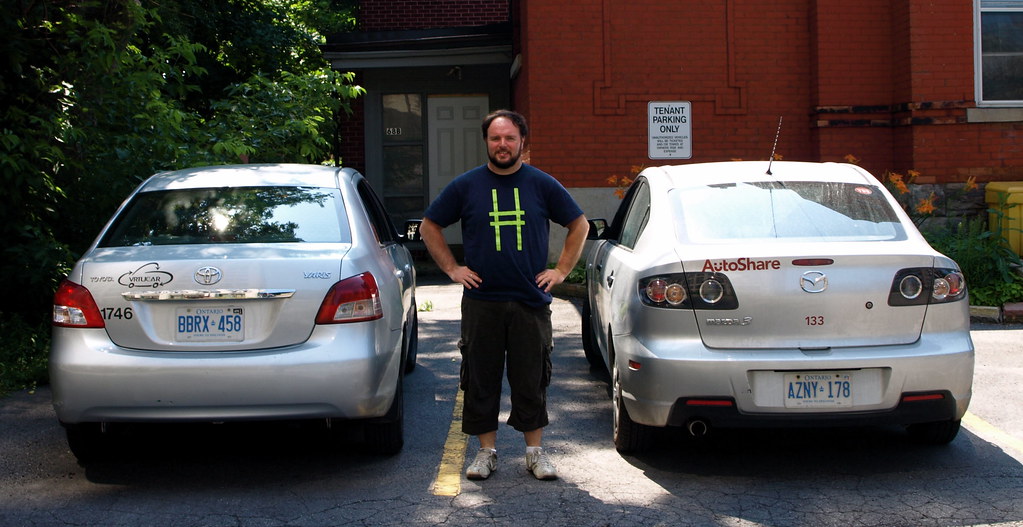
Here at Spacing Ottawa we’re big fans of Vrtucar, the car-share organization that since 2000 has been helping Ottawans in need of occasional access to an automobile get to their appointments without the necessity of owning their own personal set of wheels.
Vrtucar is part of a Canada-wide association of car-share groups, and this past week we had the unique opportunity to see an example from Toronto organization and compare it side-by-side with a local vehicle. This endeavor may well cross almost certainly crosses the line into car-share geekery, so fair warning — female and other socially well-adjusted readers may want to look away now.
The car on the right of the picture above is the Toronto one, generously lent to Spacing publisher Matthew Blackett by Auto Share in support of the Spacing Roadshow series of events this July. With a typical car-share booking being for two hours or less (though long-distance rates are available) it’s fair to say that it is unusual to see a car-share vehicle from another city on the streets of Ottawa, much less being used as highway transportation for a cross-Canada tour — all the more reason we were keen to kick the tires and look for differences between cars from the two organizations.
The first thing we noticed was the make itself; whereas Vrtucar has long relied on Toyotas (first with Echos, then Yarises, now starting to shift to Corollas) it is Mazda sedans like the one above that seem to be the mainstay of the Autoshare fleet, though they actually have 17 or 18 other makes and models on offer as well, depending on location. And Toronto has electric cars, too, including, their site says “Canada’s first plug-in Toyota Prius”
Fleet cars all need their vehicle identification numbers, and while Ottawa goes with a discreet white decal on the back of the rear-view mirror that didn’t show up through the windshield glare in the photos we took, the vehicle identification number is displayed prominently on Autoshare windshields with a red decal:
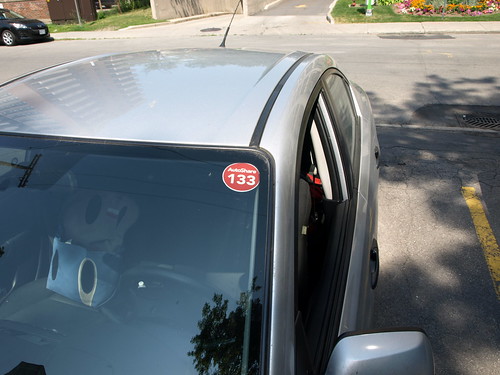
Toronto also does things a little differently with the entry key. Both organizations use a satellite transponder on the inside of the windshield to unlock the doors, but where Ottawa uses a keychain “e-fob” like this one:
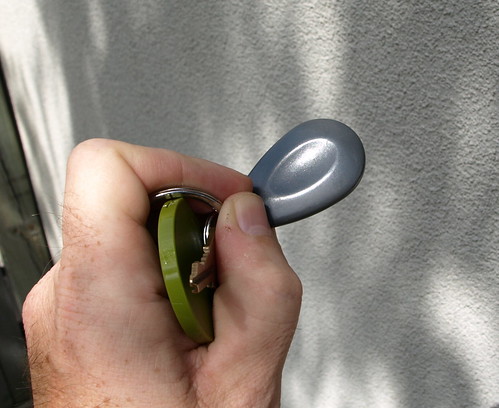
Toronto uses a wallet card like this one:
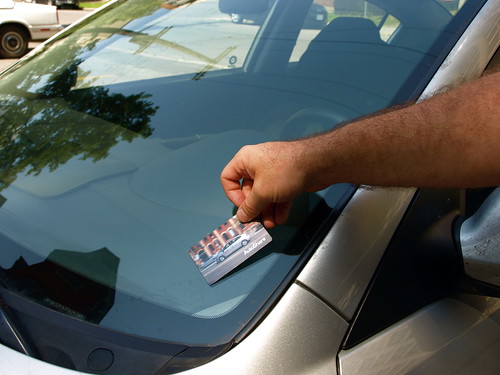
Six of one and half-dozen of the other you might say, except that the Toronto wallet card is a kind of advertising too, a nice visual that helps users “show-off” about the organization to friends and acquaintances, while displaying important contact numbers as well.
Once you are inside the car, the ignition key is on a retractable wire cable in both Toronto and Ottawa cars; like this:
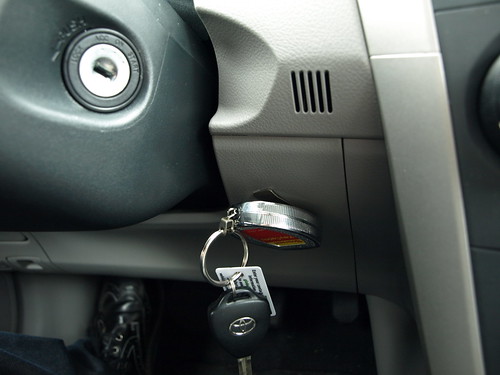
Finally, there is the log book. Every trip must be recorded so that the total time and mileage can be properly billed to the user.
 That’s a pretty straightforward function as far as it goes, but it’s also a chance for the organization to remind you of your duties and responsibilities as a user. So while the basic logbook form is very similar between the two services, we spotted an extra “housekeeping” clause on top of the signature line on the Toronto form. Here’s what it says, in part:
That’s a pretty straightforward function as far as it goes, but it’s also a chance for the organization to remind you of your duties and responsibilities as a user. So while the basic logbook form is very similar between the two services, we spotted an extra “housekeeping” clause on top of the signature line on the Toronto form. Here’s what it says, in part:
“I confirm that all of the information I have entered is accurate, and the vehicle is safe and ready for the next member. The interior is at least as clean as I found it.”
Vrtucars are actually well-looked after, and most users are responsible members who pick up after themselves. As well, the service employs staff whose job it is to give the cars regular cleaning.
But to deal with those few bad apples who treat the cars like their own private wastebaskets, a lot of long-time Vrtucar users would likely agree that Toronto-style warnings — combined with strict penalties for those caught breaking the covenant –would be a useful innovation for the Ottawa car-share to consider.
UPDATE: Some comments have asked for more information concerning how to book car-share vehicle, locations, and how much they cost.
Vrtucar uses an online booking system that is available to members behind a log-in paywall, so we can’t display that information, but basically you enter your preferred location and your time, and the available vehicles are displayed – you choose the one closest to you in the time you want, and you get an email confirmation saying the car is yours. Locations? Here’s what Vrtucar says about locations and size of their fleet:
VRTUCARs are located in the following Ottawa neighbourhoods:
Billings Bridge, Britannia Village, Byward Market, Carlingwood, Centretown, Glebe, Hintonburg, New Edinburgh, Old Ottawa East, Old Ottawa South, Sandy Hill, Vanier, Westboro and West Wellington. We maintain the same ratio of cars to members – every 18-20 new members means we add another car to the fleet.
You can get a sense of how AutoShare has a similar location-based booking system by viewing their locations map.
From experience, we can say that you are more likely to get the car you want if you book in advance, though for most spontaneous bookings during the day Monday through Friday we nearly always find a car available nearby. Evenings from 6 -10 are a little more tight, though still fairly easy to get a car with a day’s notice, and weekends are the most intensively booked and often need advance booking – say 4 to 10 days in advance.
Pricing schemes are really flexible at Vrtucar, with the cheapest hourly rates going to full members who have paid the fully-refundable 500 dollar membership fee, and kilometerage varying between 17 to 46 cents per km, depending on your kind of membership.
Autoshare has its own tiered system of pricing – but the one thing the both systems have in common is that the prices are inclusive of gas, insurance, and maintenance.
This means that other than membership costs, which vary between “free” and up to 30 dollars per month, billing is based on two factors – hours booked, and distance fees by kilometer.

10 comments
So what about pricing differences, booking system, availability, number of depots?
Got to say as a regular Vrtucar user who’s also fairly scattered at times, I much prefer the e-fob to the wallet card. I just know that I would forget the wallet card somewhere, and then get to the car with no way to open it. I am never without my keys, though. . .
The new e-fobs are much smaller and thinner, BTW. About the shape of a guitar pick and maybe half again as big. Not the grey bulbs they used to be. At least, the new one I got when I lost mine earlier this year is that size.
The card makes a good walking ad, true. But I find just the key fob is a conversation starter. Fairly often, someone will see me activating the car, and say, “What the heck is that? a security system?” and then I explain, and usually extol the advantages of Vrtucar at the same time…
Yeah, I agree with JM. All the most important points have been overlooked in this article. Price, booking, availability etc etc.
This would be much more useful than the surface information given here.
JM and Mike – we have added information about pricing and locations to the post as per your suggestions – thanks for the feedback
Also, in order to get the best deal for Vrtucar, it’s 30$ a month. If you’re not going to use it frequently, it’s only 3.50$ a month for insurance but it’s 8$ an hour instead of 3.50 an hour. It’s a little complicated, but I find it works if you’re able to book the time you want.
Shared cars from other cities aren’t that uncommon in Ottawa, if you include CommunAuto from Québec.
I’d suspect that it’s been easier for the Toronto company to expand to new, convenient spaces through Section 37 agreements requiring carsharing services/spots. Maybe Vrtucar will see a (larger than usual) growth spurt when Ottawa starts to make Section 37 a more regular occurrence.
It would be nice to see a table of hourly rates, distance rates, cheap periods, etc.
So far as I know, Autoshare does not yet having ‘roaming’ with other carshare services.
I think it would be great to see Autoshare join the Communato/Virtucar arrangement for members using the other group’s vehicles.
So long as they are far apart, it will mostly a convenience for business travelers and perhaps the odd tourist, but as more members join and the idea of carsharing spreads, we may see this service in more smaller communities between the big cities. (ie, Kingston, Belleville, Oshawa etc.)
I saw a CommunAuto car in New Brunswick last week.
I’m a recently ex-member of Autoshare, having just bought a car, but had five positive years with them.
Autoshare has recently completed its switch from mechanically keyed lockboxes to that swipe card. What’s good about the card is that if you arrange it properly in your wallet (presuming you keep your cards in your wallet) then you don’t have to take it out to swipe it. “Properly” means with the card just inside the outer wallet covering. I always have my wallet, so this works nicely.
The reporting sheet that you show is now resting with the fishes as well as with the old keys. Now it’s all done by remote signup via that satellite (really a cell-phone connection, surely?) — disconcerting for oldtimers used to having to sign for their good behaviour, but definitely easier.
Lastly, if you live in the right part of Toronto, namely downtownish, there are really a lot of Autoshare locations (and about as many Zipcar). I can easily walk to about five in under a kilometre from home.
I often visit Ottawa, but have never needed to pay attention to car sharing there. It’s good to know it works well.